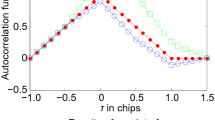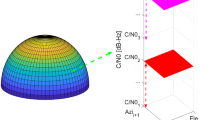Abstract
Urban environments present significant challenges to global navigation satellite system (GNSS) positioning. GNSS signals are often obstructed by buildings and other obstacles, leading to reflection and diffraction, which cause major line-of-sight (LOS) and non-line-of-sight (NLOS) multipath positioning errors. We propose a new, precise GNSS positioning technique that can simultaneously mitigate LOS and NLOS multipath errors by rotating the GNSS antenna arm horizontally at a certain angular velocity. The key idea behind this technique is to use the antenna motion to mitigate the LOS multipath effect and detect the NLOS multipath signals. The relative carrier phase between the direct signal and the multipath signal frequently changes when a GNSS antenna is moving. As a result, the effect that the strong reflected signal affects the direct signal can be reduced. We use this characteristic to mitigate LOS multipath errors by generating antenna motion. By rotating a GNSS antenna, the Doppler frequency is produced by the antenna motion. If the received GNSS signal is the NLOS signal, the direction of incoming signals is different from that of direct signals. In this situation, the phase of the generated Doppler frequency will be different, and NLOS signals can be detected by comparison with the ideal Doppler frequency. We conducted an experiment to evaluate the proposed method. The positioning error of the proposed method using LOS multipath mitigation and NLOS exclusion by the rotating antenna was decreased from 18.96 to 2.83 m. In addition, the availability of GNSS positioning increased from 44.29 to 100%.
















Similar content being viewed by others
Data availability
The datasets generated during and/or analyzed during the current study are available from the corresponding author on reasonable request.
References
Braasch MS (2001) Performance comparison of multipath mitigating receiver architectures. In: Proceedings of the IEEE aerospace conference. Big Sky, MT, USA, pp 31309–31315
van den Brekel BJH, van Nee DJR (1992) GPS multipath mitigation by antenna movements. Electron Lett 28:2286–2288. https://doi.org/10.1049/el:19921471
Daneshmand S, Broumandan A, Sokhandan N, Lachapelle G (2013) GNSS multipath mitigation with a moving antenna array. IEEE Trans Aerosp Electron Syst 49:693–698. https://doi.org/10.1109/TAES.2013.6404136
Ertan T, Psiaki M, O’Hanlon B, Merluzzi R (2013) GNSS Multipath Mitigation using High-Frequency Antenna Motion. In: Proceedings of ION GNSS+ 2013, institute of navigation. Nashville, Tennessee, USA, pp 154–175
Garin L, van Diggelen F, Rousseau JM (1996) Strobe and edge correlator multipath mitigation for code. In: Proceedings of ION GPS 1996, institute of navigation. Kansas City, Missouri, USA, pp 657–664
Groves PD (2011) Shadow matching: a new GNSS positioning technique for urban canyons. J Navig 64:417–430. https://doi.org/10.1017/S0373463311000087
Groves PD, Adjrad M (2017) Likelihood-based GNSS positioning using LOS/NLOS predictions from 3D mapping and pseudoranges. GPS Solut 21:1805–1816. https://doi.org/10.1007/s10291-017-0654-1
Groves PD, Jiang Z (2013) Height aiding, C/N0 weighting and consistency checking for GNSS NLOS and multipath mitigation in urban areas. J Navig 66:653–669. https://doi.org/10.1017/S0373463313000350
Groves PD, Jiang Z, Rudi M, Strode P (2013) A portfolio approach to NLOS and multipath mitigation in dense urban areas. In: Proceedings of ION GNSS+ 2013, institute of navigation. Nashville, Tennessee, USA, pp 3231–3247
Hsu LT, Gu Y, Kamijo S (2016) 3D building model-based pedestrian positioning method using GPS/GLONASS/QZSS and its reliability calculation. GPS Solut 20:413–428. https://doi.org/10.1007/s10291-015-0451-7
Kaplan E, Hegarty C (2005) Understanding GPS: principles and applications. Artech House, Norwood
Keshvadi MH, Broumandan A, Lachapelle G (2011) Analysis of GNSS beamforming and angle of arrival estimation in multipath environments. In: Proceedings of ION ITM 2013, institute of navigation. San Diego, CA, USA, pp 427–435
Kubo N, Kikuchi R, Higuchi M (2015) A unique approach to strong multipath mitigation in dense urban areas. In: Proceedings of ION GNSS+ 2015, institute of navigation. Tampa, Florida, USA, pp 2905–2913
Kubo N, Kobayashi K, Hsu LT, Amai O (2017) Multipath mitigation technique under strong multipath environment using multiple antennas. J Aeronaut Astronaut Aviat 49:75–82. https://doi.org/10.6125/17-0130-928
Maier D, Kleiner A (2010) Improved GPS sensor model for mobile robots in urban terrain. In: Proceedings of IEEE international conference on robotics and automation. Anchorage, Alaska, USA, pp 4385–4390
Marais J, Berbineau M, Heddebaut M (2005) Land mobile GNSS availability and multipath evaluation tool. IEEE Trans Veh Technol 54:1697–1704. https://doi.org/10.1109/TVT.2005.853461
Psiaki ML, Ertan T, O’Hanlon BW, Powell SP (2015) GNSS multipath mitigation using antenna motion. Navig J Inst Navig 62:1–22. https://doi.org/10.1002/navi.79
Soubielle J, Fijalkow I, Duvaut P, Bibaut A (2002) GPS positioning in a multipath environment. IEEE Trans Signal Process 50:141–150. https://doi.org/10.1109/78.972490
Suzuki T (2016) Integration of GNSS positioning and 3D map using particle filter. In: Proceedings of ION GNSS+ 2016, institute of navigation. Portland, Oregon, USA, pp 1296–1304
Suzuki T, Kubo N (2013) Correcting GNSS multipath errors using a 3D surface model and particle filter. In: Proceedings of ION GNSS+ 2013, institute of navigation. Nashville, Tennessee, USA, pp 1583–1595
Suzuki T, Kubo N (2014) N-LOS GNSS signal detection using fish-eye camera for vehicle navigation in urban environments. In: Proceedings of ION GNSS+ 2014, institute of navigation. Tampa, Florida, USA, pp 1897–1906
Suzuki T, Kubo N, Yasuda A (2004) The possibility of the precise positioning and multipath error mitigation in the real-time. In: Proceedings of the 2004 international symposium on GNSS/GPS. Sydney, Australia
Suzuki T, Kitamura M, Amano Y, Hashizume T (2011) Multipath mitigation using omnidirectional infrared camera for tightly coupled GPS/INS integration in urban environments. In: Proceedings of ION GNSS 2011, institute of navigation. Portland, Oregon, USA, pp 2914–2922
Takasu T, Yasuda A (2009) Development of the low-cost RTK-GPS receiver with an open source program package RTKLIB. In: Proceeding of the international symposium on GPS/GNSS. Jeju, Korea
Tokura H, Yamada H, Kubo N, Pullen S (2014) Using multiple GNSS constellations with strict quality constraints for more accurate positioning in urban environments. Positioning 05:85–96. https://doi.org/10.4236/pos.2014.54011
Tranquilla JM, Carr JP, Al-Rizzo HM (1994) Analysis of a choke ring groundplane for multipath control in global positioning system (GPS) applications. IEEE Trans Antennas Propag 42:905–911. https://doi.org/10.1109/8.299591
Vagle N, Broumandan A, Jafarnia-Jahromi A, Lachapelle G (2016) Performance analysis of GNSS multipath mitigation using antenna arrays. J Glob Position Syst. https://doi.org/10.1186/s41445-016-0004-6
Van Dierendonck AJ, Fenton P, Ford T (1992) Theory and performance of narrow correlator spacing in a GPS receiver. Navig J Inst Navig 39:265–283. https://doi.org/10.1002/j.2161-4296.1992.tb02276.x
Wang J, Zhang K (2018) Low-cost positioning with rotating antenna in constrained environment for global navigation satellite systems. Electron Lett 54:45–47. https://doi.org/10.1049/el.2017.3381
Wen W, Zhang G, Hsu LT (2019) Correcting NLOS by 3D LiDAR and building height to improve GNSS single point positioning. Navig J Inst Navig 66:705–718. https://doi.org/10.1002/navi.335
Yedukondalu K, Sarma AD, Satya V (2012) Estimation and mitigation of GPS multipath interference using adaptive filtering. Prog Electromagn Res M 21:133–148. https://doi.org/10.2528/PIERM11080811
Author information
Authors and Affiliations
Corresponding author
Additional information
Publisher's Note
Springer Nature remains neutral with regard to jurisdictional claims in published maps and institutional affiliations.
Rights and permissions
About this article
Cite this article
Suzuki, T., Matsuo, K. & Amano, Y. Rotating GNSS Antennas: Simultaneous LOS and NLOS Multipath Mitigation. GPS Solut 24, 86 (2020). https://doi.org/10.1007/s10291-020-01006-w
Received:
Accepted:
Published:
DOI: https://doi.org/10.1007/s10291-020-01006-w




